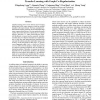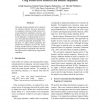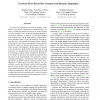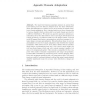AAAI
2012
12 years 5 months ago
2012
The study of transportability aims to identify conditions under which causal information learned from experiments can be reused in a different environment where only passive obser...
AAAI
2012
12 years 5 months ago
2012
Transfer learning proves to be effective for leveraging labeled data in the source domain to build an accurate classifier in the target domain. The basic assumption behind transf...
ACL
2012
12 years 5 months ago
2012
Extracting sentiment and topic lexicons is important for opinion mining. Previous works have showed that supervised learning methods are superior for this task. However, the perfo...
ACL
2012
12 years 5 months ago
2012
This paper presents grammar error correction for Japanese particles that uses discriminative sequence conversion, which corrects erroneous particles by substitution, insertion, an...
CVPR
2012
IEEE
12 years 5 months ago
2012
IEEE
In real-world applications of visual recognition, many factors—such as pose, illumination, or image quality—can cause a significant mismatch between the source domain on whic...
CVPR
2012
IEEE
12 years 5 months ago
2012
IEEE
Visual domain adaptation addresses the problem of adapting the sample distribution of the source domain to the target domain, where the recognition task is intended but the data d...
PAMI
2012
12 years 5 months ago
2012
—Cross-domain learning methods have shown promising results by leveraging labeled patterns from the auxiliary domain to learn a robust classifier for the target domain which has ...
109
click to vote
DAGM
2011
Springer
13 years 2 months ago
2011
Springer
The supervised learning paradigm assumes in general that both training and test data are sampled from the same distribution. When this assumption is violated, we are in the setting...
AAAI
2011
13 years 2 months ago
2011
Transfer learning allows knowledge to be extracted from auxiliary domains and be used to enhance learning in a target domain. For transfer learning to be successful, it is critica...
AAAI
2011
13 years 2 months ago
2011
Latent relational search (LRS) is a novel approach for mapping knowledge across two domains. Given a source domain knowledge concerning the Moon, “The Moon is a satellite of the...




